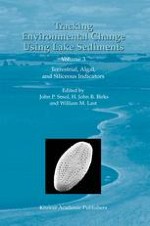2001 | Buch
Tracking Environmental Change Using Lake Sediments
Terrestrial, Algal, and Siliceous Indicators
herausgegeben von: John P. Smol, H. John B. Birks, William M. Last, Raymond S. Bradley, Keith Alverson
Verlag: Springer Netherlands
Buchreihe : Developments in Paleoenvironmental Research
Enthalten in: Professional Book Archive
